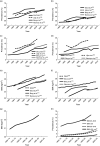Trends in consumption of ultra-processed foods and obesity in Sweden between 1960 and 2010
- PMID: 25804833
- PMCID: PMC10277202
- DOI: 10.1017/S1368980015000506
Trends in consumption of ultra-processed foods and obesity in Sweden between 1960 and 2010
Abstract
Objective: To investigate how consumption of ultra-processed foods has changed in Sweden in relation to obesity.
Design: Nationwide ecological analysis of changes in processed foods along with corresponding changes in obesity. Trends in per capita food consumption during 1960-2010 were investigated using data from the Swedish Board of Agriculture. Food items were classified as group 1 (unprocessed/minimally processed), group 2 (processed culinary ingredients) or group 3 (3·1, processed food products; and 3·2, ultra-processed products). Obesity prevalence data were pooled from the peer-reviewed literature, Statistics Sweden and the WHO Global Health Observatory.
Setting: Nationwide analysis in Sweden, 1960-2010.
Subjects: Swedish nationals aged 18 years and older.
Results: During the study period consumption of group 1 foods (minimal processing) decreased by 2 %, while consumption of group 2 foods (processed ingredients) decreased by 34 %. Consumption of group 3·1 foods (processed food products) increased by 116 % and group 3·2 foods (ultra-processed products) increased by 142 %. Among ultra-processed products, there were particularly large increases in soda (315 %; 22 v. 92 litres/capita per annum) and snack foods such as crisps and candies (367 %; 7 v. 34 kg/capita per annum). In parallel to these changes in ultra-processed products, rates of adult obesity increased from 5 % in 1980 to over 11 % in 2010.
Conclusions: The consumption of ultra-processed products (i.e. foods with low nutritional value but high energy density) has increased dramatically in Sweden since 1960, which mirrors the increased prevalence of obesity. Future research should clarify the potential causal role of ultra-processed products in weight gain and obesity.
Keywords: Industrial food processing; Obesity; Overweight; Ultra-processed food products.
Figures




References
-
- Slimani N, Deharveng G, Southgate DA et al.. (2009) Contribution of highly industrially processed foods to the nutrient intakes and patterns of middle-aged populations in the European Prospective Investigation into Cancer and Nutrition study. Eur J Clin Nutr 63, Suppl. 4, S206–S225. - PubMed
-
- Moubarac JC, Claro RM, Baraldi LG et al.. (2013) International differences in cost and consumption of ready-to-consume food and drink products: United Kingdom and Brazil, 2008–2009. Glob Public Health 8, 845–856. - PubMed
-
- Monteiro CA, Levy RB, Claro RM et al.. (2010) A new classification of foods based on the extent and purpose of their processing. Cad Saude Publica 26, 2039–2049. - PubMed
-
- Moubarac J-C, Parra D, Cannon G et al.. (2014) Food classification systems based on food processing: significance and implications for policies and actions. A systematic literature review and assessment. Curr Obes Rep 3, 256–272. - PubMed
MeSH terms
LinkOut - more resources
Full Text Sources
Medical

